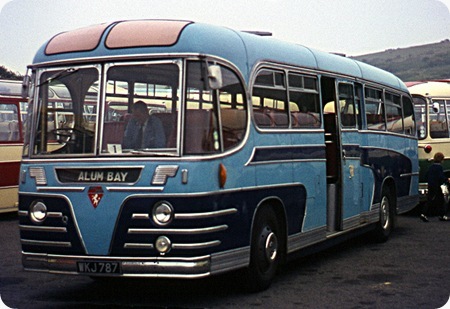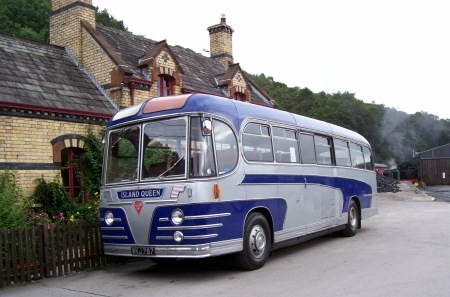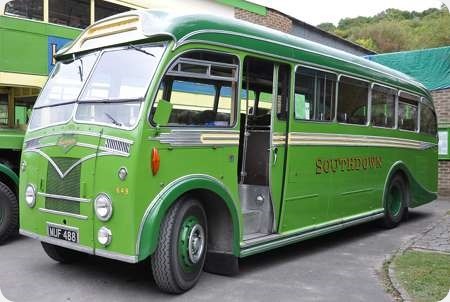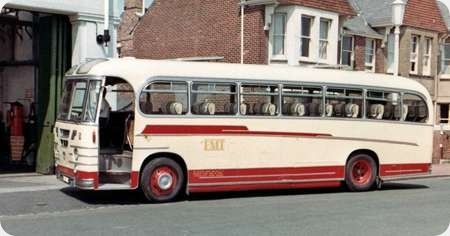
Copyright Roger Cox
Moss Tours Isle of White
1955
Beadle Rochester
Beadle C41C
This picture of WKJ 787, a Beadle Rochester C41C coach was taken in 1970 at Alum Bay, Isle of Wight. The Rochester was an integral design from the Dartford based coachbuilder, and was powered by the Rootes TS3 3 cylinder horizontally opposed piston two stroke engine, very similar to the pre war Sulzer ZG9. (The wartime Junkers Jumo aero engine operated on related principles but differed in several design aspects.) The TS3 was designed initially at the Humber works of the Rootes group, and production was undertaken at the former Tilling Stevens (hence "TS") factory in Maidstone that Rootes acquired in the autumn of 1950. Two stroke engines have a power stroke on every rotation of the crankshaft, and have to have some form of pressure charging for induction. On the TS3 (and on contemporary Foden two strokes) this was achieved by a Roots (no commercial relation to Rootes) supercharger driven by the engine, which absorbed some of the power output. The engine had a capacity of 3.26 litres and developed 105 bhp at 2400 rpm. The very distinctive exhaust note akin to a Gatling Gun in full cry earned these engine the sobriquet of "Knockers". A four cylinder 4.35 litres version was developed giving 200 bhp at 2600 rpm, and 14 prototypes ran 1.2 million miles very successfully, but this programme came to a halt with the Chrysler takeover of Rootes in 1967. Chrysler had entered into joint agreements with fellow American engineers Cummins for commercial vehicle engine supplies, and the exceptionally promising TS4 was an embarrassment to these arrangements. As it turned out, the Cummins V6 and V8 engines were a disaster. The TS3 was subsequently cancelled as well, and Chrysler turned to Perkins for the supply of smaller engines. Yet another promising British engineering achievement foundered upon corporate ignorance and myopia. //www.commer.org.nz/
The Rochester in the picture began life in 1955 as a Beadle demonstrator, and was later acquired by Moss Tours on the Isle of Wight. It was bought by a church group in the 1990s, and then thankfully sold on into preservation. To my eye, the body design is quite well proportioned, making due allowances for the ample application of chrome at the front. A recent view of this Rochester may be found here:- www.flickr.com/
Photograph and Copy contributed by Roger Cox
03/08/12 – 07:57
To my mind this is pretty much what a centre entrance Weymann Fanfare would have looked like. I’ve never seen one, so was that an option or were they all front entrance?
Ronnie Hoye
03/08/12 – 07:58
Whereas there were front entrance Rochesters there were never centre entrance Fanfares. They are suspiciously similar but I believe Weymann were on the market first and, if you ignore the Fanfare front end, the rest can be seen as pure Beadle – despite similarities. I still find it incredible, after all these years, that Beadle "got away with" the Rochester as did Duple (or was it Roe?) with the Elizabethan and the Dalesman.
This vehicle made a guest appearance at last year’s Hemel Running Day. Handsome beast, whatever.
David Oldfield
03/08/12 – 07:59
Yorkshire Woollen had a batch registered CHD 375-390 new in 1957 and these were C41F.They were all withdrawn in 1967.
Philip Carlton
03/08/12 – 08:12
I’ve seen this several times, in ISLAND QUEEN guise. Moss still exists as an operator on the Isle of Wight, as part of Southern Vectis, whose fleet has been renumbered in the last few weeks as part of an exercise involving the whole of "Go South Coast".
Pete Davies
03/08/12 – 10:56
What a lovely picture. I can see the Fanfare similarities but it smacks of Yeates in some ways too.
Les Dickinson
03/08/12 – 17:20
The TS3 was an amazing engine; a real success story in a difficult area of internal combustion technology.
General Motors also produced the Detroit Diesel with a Roots blower, as early as 1938. It was used in some British tanks, but never used in the UK other than this, to my knowledge.
Chrysler made a stupid decision to scrap development (which included plans, jigs and engines) of the TS4, which was virtually ready to go. A couple of engines survived under wraps and here is the wonderful sound of a TS4 running: www.youtube.com/
Chris Hebbron
03/08/12 – 17:21
Yes, Les, the somewhat ornate decoration does suggest the designer had a look at some Yeates products and liked what he saw. I’ve always had the idea that the Yeates decoration was overdone, on the basis of "There’s a bit here that’s still blank. Let’s decorate it!" It must have increased the body weight, surely?
Pete Davies
03/08/12 – 17:21
Southdown had 25 Rochesters the first five of which had centre entrances but the windscreens and the first body bay were quite different being more akin to the bodies fitted to Southdown’s Tiger Cubs which were being delivered around that time. The remaining twenty were standard front entrance 41 seat models which were used extensively on express services. I drove later Commer Avengers fitted with this engine which could be quite lively if revs were kept up which makes me think I would love to have tried the four cylinder version it could have had great potential another chance missed.
Diesel Dave
03/08/12 – 17:40

I have been through my archives and attached is a picture you may want to add to the current discussion. Island Queen is owned by Roger Burdett and in 2008 I was a passenger on it to Scotland via the Kirkby Stephen Rally. The day before we went to the Lakeside and Hatherwaite Railway where I took this picture. Besides the obvious change in livery the vehicle has lost one of the orange front skylights.
Ken Jones
04/08/12 – 07:45
Thanks for that link to the TS4, Chris. That sound takes me right back to the days when the Southdown Commers could be seen (and decidedly heard) sprinting along the A22 and A23 south of Croydon. The cancellation of the TS4 and discontinuation of the TS3 should be added to the sadly substantial list of corporate follies that has denuded the UK economy of much of its engineering expertise.
Roger Cox
04/08/12 – 07:46
How did it perform, Ken, and was the engine noise subdued inside?
Chris Hebbron
04/08/12 – 07:47
I couldn’t have put it better myself Pete, this is better for being a little less cluttered I think.
Les Dickinson
04/08/12 – 11:41
Reference question above from Chris Hebbron – I thought it performed well – Scotland and back with no problems – and as a passenger it gave a nice ride. It was however noisy depending where you sat, so choice of seat is very important on this vehicle as I soon discovered.
Ken Jones
04/08/12 – 17:20
The TS4 was discontinued as a result of the Rootes takeover by Chrysler who introduced the V6 in the Dodge KP Series. This engine was seriously fast outpacing the TS3 and according to my father (who used the TS4 in development on the road). Unfortunately it was an erratic engine throwing belts and of course saw its reputation totally screwed by its lack of reliability in Daimler Roadliners.
Island Queen is a delight to drive and ok for noise if you sit in the front half. It is likely to be out and about in the second half of 2013
Roger Burdett
04/08/12 – 20:46
I’m sure that the initial engine in the Roadmaster was a Cummins ‘small-V’ one, which proved troublesome to the point where it was replaced by a Perkins engine and finally a Leyland unit, none of which produced a fully acceptable solution. I’ve seen it mentioned that it was originally a marine unit and suffered from problems of responsiveness, not a problem in a marine setting. Other contemporary Cummins engines were pretty good, but the one fitted was suitably very compact.
The chassis appears also to have been prone to flexing, causing body problems.
The TS4 never really came out of R&D and into volume production, to my knowledge.
Whatever the shortcomings of the early Leyland Nationals, they acquitted themselves well in comparison with the Roadliner. Thx, Ken, for the passenger experience pointers.
Chris Hebbron
07/08/12 – 07:14
I have had a ride on this vehicle, and got the impression that the engine noise was amplified by the entrance stairwell, which is presumably right next to the engine. This suggested that a front-entrance one would probably be more refined.
Peter Williamson
13/08/12 – 08:49
Here is a link to a picture of a Rochester with a front entrance body. The pillar at the rear of the front curved corner glass has had to be repositioned from that of the centre entrance design in order to accommodate the door. This one, KPR 688, was apparently one of three Rochesters bought new by Bere Regis and District in 1957. www.flickr.com/photos/
Roger Cox
15/10/12 – 17:06
The other surviving Rochester, 8 GMK, is likely to be a couple of years before it appears on the rally scene as there are a couple of others in the queue before it gets started.
There is a lot of work to do to it, including a large dent in the rear dome and some chassis work. Plus I need to get the ‘K’ and the VAS finished first. There are quite a few shots of it at this link.
Charlie Lemon
06/05/13 – 08:19
I travelled many hundreds of miles on the Yorkshire Woollen Rochesters and always enjoyed riding on them. However, while 105 bhp is impressive on paper, my recollection is that they had no worthwhile torque whatsoever, which made hill climbing a slow and tedious business, even with a driver who knew to keep the revs up (they were the only coaches at the time fitted with a rev counter). With someone who tried to drive them like a Gardner, things became hopeless as below a certain RPM the engine switched to four stroke which halved the power.
As far as noise is concerned, I do not recall them being any worse than, say, a Leyland inside but the ones I knew had front entrances and I always sat at the front. Outside was a different matter. I used to deliver papers early in the morning and remember a brace of Rochesters heading for Blackpool in the morning stillness as they blasted their way out of Cleckheaton. They were audible for about 3 miles. Heaven only knows what a TS4 would have sounded like.
Bob Hunter
29/10/13 – 07:17
The resemblance between the Weymann Fanfare and the Beadle Rochester, which was highlighted earlier in this thread, is also mentioned in John Senior’s "The Weymann Story Part 2 1942-1966".
Apparently at a time when Weymann was highly profitable there was a disagreement between the managing director, DJA (Jack) Davies, and the owners, United Molasses, about what to do with the profits. The row became acrimonious and Davies was forced to leave. He went to Beadle in March 1955, and the Rochester appeared the following year.
Peter Williamson
06/11/13 – 16:08
On YouTube under the heading ‘QUANTOCK CLASSIC BUS DAY 2011 Part3’ a short journey aboard WKJ 787 is included in the video. The Rochester footage begins at 5.54 and lasts until 8.09, followed by a very brief ‘encore’ from 9.20 – 9.56. Sound effects from the little Commer TS3 engine are as one would expect – growly, raucous and gorgeous. It’s definitely worth watching/listening to if you like 2-stroke diesels – just make sure the neighbours are out before you turn up the volume!
Brendan Smith
07/11/13 – 07:15
Brendan: My word- I’d forgotten what it was like. An Atco with hyperdrive…. and what a driver!
Joe
 Vehicle reminder shot for this posting
Vehicle reminder shot for this posting
04/02/14 – 07:41
Does anyone have any information about WKO 136 ? apparently a demonstrator.
Dominic





